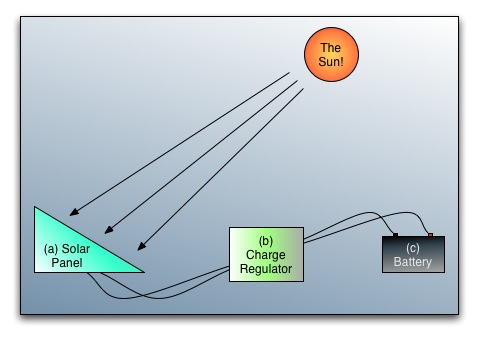To celebrate the article coauthored with Laura Robinson at Hawai’i just released (which Jane beat me to mentioning first!), here’s an article I’ve had stored up for a while… Note that the LDC article brings together and extends many of the elements discussed in my 3 previous articles from last year (1, 2, 3). In that series I hinted at using a petrol generator as a potential power source. Today I’d like to look some alternative set ups, ranging from the practical to the bizarre.
But first…I’m a big fan of the Make blog. Although, I think I’d have to class myself more as a wannabe tinkerer, than a DIY pro. I must credit Make as the source of many of these great finds over the last few months. If you’re the kind of person that wonders how to make your own GPS logger (via), or make a simple stove (via) from a couple of aluminium cans, or even if you want to make your own solar cell (via), then this is the site for you.
The other great source (often linked to from Make) is Instructables. This site is chock full of user submitted, step-by-step guides to making all sorts of weird and wonderful things, like making fire with ice and making your own mini led torch.
OK, so to revise with a picture. Here is our solar kit:

…apologies for my awful drawing skills!
Part (a) was a solar panel powerful enough to fill part (c), our battery, without destroying part (b), our charge regulator. I guess really, I should call the sun (d), our energy source, because that’s the bit I’d like to consider swapping out first. But really its the source plus the mechanism for conversion that we’ll be considering. Today, I’m concerned with alternates for part (a). In a later post I want to talk about alternates for (b) and (c)… particularly (c) where I’ve been cooking up an alternate system for storage.
Petrol/Diesel Generators
First, and perhaps the simplest. Charging a battery from a generator. Fuel is expensive, so it’s important to use your petrol efficiently! Don’t just run the generator to plug in your laptop! Make sure you’re charging your car battery using a charger (make sure your generator can supply enough power… 16 Amps is a lot!). In fact, if you can, get a charger that draws slightly less watts than your generator is capable of and only charge your battery when using the generator. A couple of hours of charging (or less) to fill up your battery system means you can sit (and record) in silence drawing power from your battery instead of using a fraction of the power that the generator is actually supplying, and wasting all that petrol.
This was particularly important where I was late 2005 – early 2006, as we had to carry in all our stuff as the roads were bagarap. Most chargers will stop charging once the battery is full, so there’s no need for the charge regulator if you do it this way, but its a good idea to invest in some hardware to indicate the battery level.
There are in fact several factors to bare in mind when using lead acid batteries. I strongly recommend reading up on them before you dive into this stuff. First of all, if you can get one, a deep cycle battery is going to be better than a standard car battery, second, your charge rate (in Amps) shouldn’t than 1/10th of the AmpHours capacity of the battery, or you risk damaging it. I’ve mentioned it before, but the ambient temperature effects the numbers in terms of charging and maintenance. If your not in a temperate climate, then be sure to check the manufacturers information.
If you’re feeling adventurous, why not try and make your own generator!
Wind Power
If you’re in a windy area, you could consider lugging in a wind generator. 71.5 kg is a lot to carry round though. Or you could always…make your own! (there’s a bit of theme going here…)
As wind speeds pick up, wind generators can generate a lot of power, so its a great option if you can get it to your location. The other good thing is you can be generating power, potentially, 24/7. Although, being in a windy area, you might want to consider a wind shield for your recordings.
Much lighter, but much less powerful, this hobby kit looks interesting… I’m considering taking one with me next time as a backup to a solar solution. Its 10 volts, so it wont charge a 12v battery.
Hydro Power
If you’re in an area with a stable flow of water, you could try a hydro-powered solution. I’m guessing it wouldn’t work on a flood plain. Here’s some links for you to get started.
well that’ll do for now, the rest will have to be in a second post!
 Follow
Follow